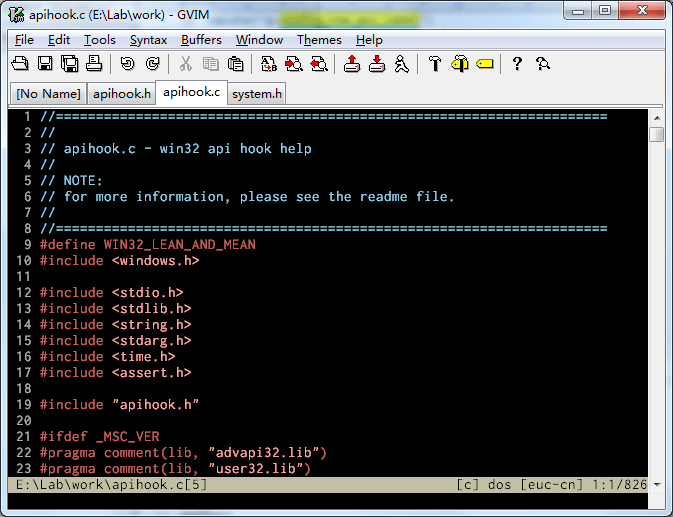更好的使用 Vim7.0 以后推出的标签(TAB)功能,同现代编辑器一样用标签(TAB)来管理多文件,代替传统 Buffer List:

让 Minibufexplor/tabbar 这些上个世纪的插件都退场吧,直接使用标准的标签功能会更加舒服。
快捷键切换 TAB
第一件事情就是要搞定标签快速切换问题,不管是 :tabn X 还是 Xgt 都十分低效,我们需要更快速的在各个文件之间切换。最简单的是设置 0-9 来快速切换 tab(默认 leader 是反斜杠,即先按下 \ 键,再按数字键),不管终端还是 GVIM 都兼容:
noremap <silent><tab>m :tabnew<cr>
noremap <silent><tab>e :tabclose<cr>
noremap <silent><tab>n :tabn<cr>
noremap <silent><tab>p :tabp<cr>
noremap <silent><leader>t :tabnew<cr>
noremap <silent><leader>g :tabclose<cr>
noremap <silent><leader>1 :tabn 1<cr>
noremap <silent><leader>2 :tabn 2<cr>
noremap <silent><leader>3 :tabn 3<cr>
noremap <silent><leader>4 :tabn 4<cr>
noremap <silent><leader>5 :tabn 5<cr>
noremap <silent><leader>6 :tabn 6<cr>
noremap <silent><leader>7 :tabn 7<cr>
noremap <silent><leader>8 :tabn 8<cr>
noremap <silent><leader>9 :tabn 9<cr>
noremap <silent><leader>0 :tabn 10<cr>
noremap <silent><s-tab> :tabnext<CR>
inoremap <silent><s-tab> <ESC>:tabnext<CR>
其次,GVIM/MacVim 下设置 ALT-0-9 来切换TAB:
" keymap to switch table in gui
if has('gui_running')
set winaltkeys=no
set macmeta
noremap <silent><c-tab> :tabprev<CR>
inoremap <silent><c-tab> <ESC>:tabprev<CR>
noremap <silent><m-1> :tabn 1<cr>
noremap <silent><m-2> :tabn 2<cr>
noremap <silent><m-3> :tabn 3<cr>
noremap <silent><m-4> :tabn 4<cr>
noremap <silent><m-5> :tabn 5<cr>
noremap <silent><m-6> :tabn 6<cr>
noremap <silent><m-7> :tabn 7<cr>
noremap <silent><m-8> :tabn 8<cr>
noremap <silent><m-9> :tabn 9<cr>
noremap <silent><m-0> :tabn 10<cr>
inoremap <silent><m-1> <ESC>:tabn 1<cr>
inoremap <silent><m-2> <ESC>:tabn 2<cr>
inoremap <silent><m-3> <ESC>:tabn 3<cr>
inoremap <silent><m-4> <ESC>:tabn 4<cr>
inoremap <silent><m-5> <ESC>:tabn 5<cr>
inoremap <silent><m-6> <ESC>:tabn 6<cr>
inoremap <silent><m-7> <ESC>:tabn 7<cr>
inoremap <silent><m-8> <ESC>:tabn 8<cr>
inoremap <silent><m-9> <ESC>:tabn 9<cr>
inoremap <silent><m-0> <ESC>:tabn 10<cr>
endif
或者在 MacVim 下还可以用 CMD_0-9 快速切换,按着更舒服:
if has("gui_macvim")
set macmeta
noremap <silent><c-tab> :tabprev<CR>
inoremap <silent><c-tab> <ESC>:tabprev<CR>
noremap <silent><d-1> :tabn 1<cr>
noremap <silent><d-2> :tabn 2<cr>
noremap <silent><d-3> :tabn 3<cr>
noremap <silent><d-4> :tabn 4<cr>
noremap <silent><d-5> :tabn 5<cr>
noremap <silent><d-6> :tabn 6<cr>
noremap <silent><d-7> :tabn 7<cr>
noremap <silent><d-8> :tabn 8<cr>
noremap <silent><d-9> :tabn 9<cr>
noremap <silent><d-0> :tabn 10<cr>
inoremap <silent><d-1> <ESC>:tabn 1<cr>
inoremap <silent><d-2> <ESC>:tabn 2<cr>
inoremap <silent><d-3> <ESC>:tabn 3<cr>
inoremap <silent><d-4> <ESC>:tabn 4<cr>
inoremap <silent><d-5> <ESC>:tabn 5<cr>
inoremap <silent><d-6> <ESC>:tabn 6<cr>
inoremap <silent><d-7> <ESC>:tabn 7<cr>
inoremap <silent><d-8> <ESC>:tabn 8<cr>
inoremap <silent><d-9> <ESC>:tabn 9<cr>
inoremap <silent><d-0> <ESC>:tabn 10<cr>
noremap <silent><d-o> :browse tabnew<cr>
inoremap <silent><d-o> <ESC>:browse tabnew<cr>
endif
这下很舒服了,和大部分主流编辑器一样切换tab十分轻松。那终端下 alt没法很好的映射怎么办呢?
终端下映射 ALT-0-9 快速切换标签
不推荐把中断里的 ALT 键设置成 ESC+,大部分终端(XShell, SecureCRT, iTerm, gnome-terminal)都提供 ALT 键改为 ESC+ 的模式,即按下 ALT-A,终端会连续发送 ESC(27) 和 A(65) 两个字节,正确设置见:
不需要 ALT 键的话可以继续往下。
设置标签文本
默认的标签文本包含文件路径,十分凌乱,需要进一步修改,让它只显示文件名:
" make tabline in terminal mode
function! Vim_NeatTabLine()
let s = ''
for i in range(tabpagenr('$'))
" select the highlighting
if i + 1 == tabpagenr()
let s .= '%#TabLineSel#'
else
let s .= '%#TabLine#'
endif
" set the tab page number (for mouse clicks)
let s .= '%' . (i + 1) . 'T'
" the label is made by MyTabLabel()
let s .= ' %{Vim_NeatTabLabel(' . (i + 1) . ')} '
endfor
" after the last tab fill with TabLineFill and reset tab page nr
let s .= '%#TabLineFill#%T'
" right-align the label to close the current tab page
if tabpagenr('$') > 1
let s .= '%=%#TabLine#%999XX'
endif
return s
endfunc
" get a single tab name
function! Vim_NeatBuffer(bufnr, fullname)
let l:name = bufname(a:bufnr)
if getbufvar(a:bufnr, '&modifiable')
if l:name == ''
return '[No Name]'
else
if a:fullname
return fnamemodify(l:name, ':p')
else
return fnamemodify(l:name, ':t')
endif
endif
else
let l:buftype = getbufvar(a:bufnr, '&buftype')
if l:buftype == 'quickfix'
return '[Quickfix]'
elseif l:name != ''
if a:fullname
return '-'.fnamemodify(l:name, ':p')
else
return '-'.fnamemodify(l:name, ':t')
endif
else
endif
return '[No Name]'
endif
endfunc
" get a single tab label
function! Vim_NeatTabLabel(n)
let l:buflist = tabpagebuflist(a:n)
let l:winnr = tabpagewinnr(a:n)
let l:bufnr = l:buflist[l:winnr - 1]
return Vim_NeatBuffer(l:bufnr, 0)
endfunc
" get a single tab label in gui
function! Vim_NeatGuiTabLabel()
let l:num = v:lnum
let l:buflist = tabpagebuflist(l:num)
let l:winnr = tabpagewinnr(l:num)
let l:bufnr = l:buflist[l:winnr - 1]
return Vim_NeatBuffer(l:bufnr, 0)
endfunc
" setup new tabline, just like %M%t in macvim
set tabline=%!Vim_NeatTabLine()
set guitablabel=%{Vim_NeatGuiTabLabel()}
在 GUI 模式下,还可以配置标签的 TIPS,鼠标移动到标签上,会自动显示该 TIPS:
" get a label tips
function! Vim_NeatGuiTabTip()
let tip = ''
let bufnrlist = tabpagebuflist(v:lnum)
for bufnr in bufnrlist
" separate buffer entries
if tip != ''
let tip .= " \n"
endif
" Add name of buffer
let name = Vim_NeatBuffer(bufnr, 1)
let tip .= name
" add modified/modifiable flags
if getbufvar(bufnr, "&modified")
let tip .= ' [+]'
endif
if getbufvar(bufnr, "&modifiable")==0
let tip .= ' [-]'
endif
endfor
return tip
endfunc
set guitabtooltip=%{Vim_NeatGuiTabTip()}
快速在标签中打开文件
除了 :tabedit 外,Vim 自带 netrw 插件可以浏览目录,是代替 nerdtree 的好东西,使用 :Explore 打开 netrw 的文件浏览器后,选中文件按t键即可以再新标签打开对应文件了。
快捷键在标签打开新文件
我们配置按下 ALT-O 的时候在当前位置打开文件浏览器:
" Open Explore in new tab with current directory
function! Open_Explore(where)
let l:path = expand("%:p:h")
if l:path == ''
let l:path = getcwd()
endif
if a:where == 0
exec 'Explore '.fnameescape(l:path)
elseif a:where == 1
exec 'vnew'
exec 'Explore '.fnameescape(l:path)
else
exec 'tabnew'
exec 'Explore '.fnameescape(l:path)
endif
endfunc
这样可以把 call Open_Explore(2) 映射成 ALT-O,这样如果在编辑一个文件时候按下 ALT-O,那么会在该文件的路径下展开一个新的 tab 并显示 netrw 的文件列表。
如果使用 GVIM/MacVim 可以更优雅点,直接在当前文件的路径下,使用系统的文件查找窗口,选中文件后在新的 Tab 里打开:
function! s:Filter_Push(desc, wildcard)
let g:browsefilter .= a:desc . " (" . a:wildcard . ")\t" . a:wildcard . "\n"
endfunc
let g:browsefilter = ''
call s:Filter_Push("All Files", "*")
call s:Filter_Push("C/C++/Object-C", "*.c;*.cpp;*.cc;*.h;*.hh;*.hpp;*.m;*.mm")
call s:Filter_Push("Python", "*.py;*.pyw")
call s:Filter_Push("Text", "*.txt")
call s:Filter_Push("Vim Script", "*.vim")
function! Open_Browse(where)
let l:path = expand("%:p:h")
if l:path == '' | let l:path = getcwd() | endif
if exists('g:browsefilter') && exists('b:browsefilter')
if g:browsefilter != ''
let b:browsefilter = g:browsefilter
endif
endif
if a:where == 0
exec 'browse e '.fnameescape(l:path)
elseif a:where == 1
exec 'browse vnew '.fnameescape(l:path)
else
exec 'browse tabnew '.fnameescape(l:path)
endif
endfunc
然后把 call Open_Browse(2) 映射成 ALT-O。
寻找Tag时在新标签打开
以前寻找tag时使用 <C-]> ,现在改为 <c-w><c-]> 即可在新标签打开 tag 定义。
Quickfix 中在新标签打开文件
编译或者 grep 的时候,信息输出到 Quickfix 窗口中,按回车就容易把 buf 给切换走,使用标签后设置下面一项,即可更改 quickfix 行为为:如果有已打开文件,先复用,没有的话使用标签:
set switchbuf=useopen,usetab,newtab
如此Tab已经很好用了,再配置一些快捷键按 ALT-方向键 来 tabmove,ALT-w 来关闭标签,基本上和其他现代编辑器行为很类似了。
![]()
